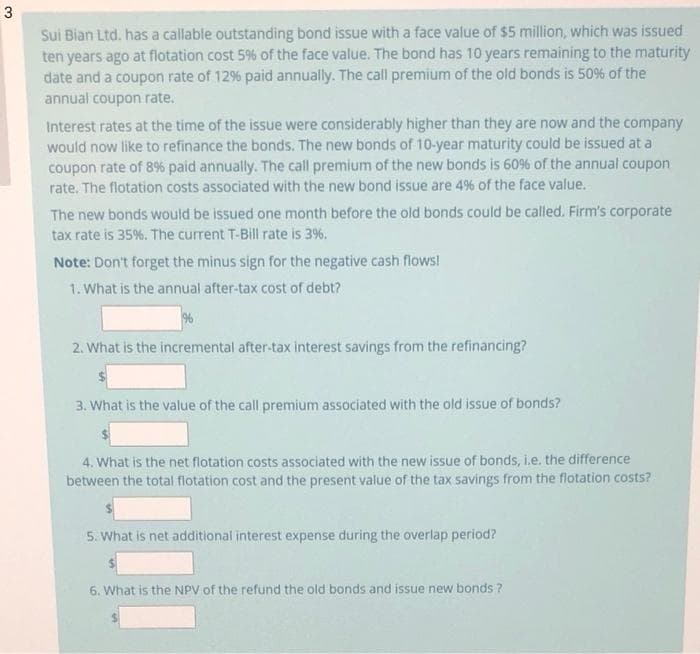Sui Bian Ltd. has a callable outstanding bond issue with a face value of $5 million, which was issued ten years ago at flotation cost 5% of the face value. The bond has 10 years remaining to the maturity date and a coupon rate of 12% paid annually. The call premium of the old bonds is 50% of the annual coupon rate. Interest rates at the time of the issue were considerably higher than they are now and the company would now like to refinance the bonds. The new bonds of 10-year maturity could be issued at a coupon rate of 8% paid annually. The call premium of the new bonds is 60% of the annual coupon rate. The flotation costs associated with the new bond issue are 4% of the face value. The new bonds would be issued one month before the old bonds could be called. Firm's corporate tax rate is 35%. The current T-Bill rate is 3%. Note: Don't forget the minus sign for the negative cash flows! 1. What is the annual after-tax cost of debt? 2. What is the incremental after-tax interest savings from the refinancing? 3. What is the value of the call premium associated with the old issue of bonds?
Sui Bian Ltd. has a callable outstanding bond issue with a face value of $5 million, which was issued ten years ago at flotation cost 5% of the face value. The bond has 10 years remaining to the maturity date and a coupon rate of 12% paid annually. The call premium of the old bonds is 50% of the annual coupon rate. Interest rates at the time of the issue were considerably higher than they are now and the company would now like to refinance the bonds. The new bonds of 10-year maturity could be issued at a coupon rate of 8% paid annually. The call premium of the new bonds is 60% of the annual coupon rate. The flotation costs associated with the new bond issue are 4% of the face value. The new bonds would be issued one month before the old bonds could be called. Firm's corporate tax rate is 35%. The current T-Bill rate is 3%. Note: Don't forget the minus sign for the negative cash flows! 1. What is the annual after-tax cost of debt? 2. What is the incremental after-tax interest savings from the refinancing? 3. What is the value of the call premium associated with the old issue of bonds?
Chapter6: Fixed-income Securities: Characteristics And Valuation
Section: Chapter Questions
Problem 17P
Related questions
Question

Transcribed Image Text:Sui Bian Ltd. has a callable outstanding bond issue with a face value of $5 million, which was issued
ten years ago at flotation cost 5% of the face value. The bond has 10 years remaining to the maturity
date and a coupon rate of 12% paid annually. The call premium of the old bonds is 50% of the
annual coupon rate.
Interest rates at the time of the issue were considerably higher than they are now and the company
would now like to refinance the bonds. The new bonds of 10-year maturity could be issued at a
coupon rate of 8% paid annually. The call premium of the new bonds is 60% of the annual coupon
rate. The flotation costs associated with the new bond issue are 4% of the face value.
The new bonds would be issued one month before the old bonds could be called. Firm's corporate
tax rate is 35%. The current T-Bill rate is 3%.
Note: Don't forget the minus sign for the negative cash flows!
1. What is the annual after-tax cost of debt?
2. What is the incremental after-tax interest savings from the refinancing?
3. What is the value of the call premium associated with the old issue of bonds?
4. What is the net flotation costs associated with the new issue of bonds, i.e. the difference
between the total flotation cost and the present value of the tax savings from the flotation costs?
5. What is net additional interest expense during the overlap period?
6. What is the NPV of the refund the old bonds and issue new bonds ?
3.
Expert Solution
This question has been solved!
Explore an expertly crafted, step-by-step solution for a thorough understanding of key concepts.
Step by step
Solved in 2 steps with 3 images

Knowledge Booster
Learn more about
Need a deep-dive on the concept behind this application? Look no further. Learn more about this topic, finance and related others by exploring similar questions and additional content below.Recommended textbooks for you

EBK CONTEMPORARY FINANCIAL MANAGEMENT
Finance
ISBN:
9781337514835
Author:
MOYER
Publisher:
CENGAGE LEARNING - CONSIGNMENT

Intermediate Financial Management (MindTap Course…
Finance
ISBN:
9781337395083
Author:
Eugene F. Brigham, Phillip R. Daves
Publisher:
Cengage Learning


EBK CONTEMPORARY FINANCIAL MANAGEMENT
Finance
ISBN:
9781337514835
Author:
MOYER
Publisher:
CENGAGE LEARNING - CONSIGNMENT

Intermediate Financial Management (MindTap Course…
Finance
ISBN:
9781337395083
Author:
Eugene F. Brigham, Phillip R. Daves
Publisher:
Cengage Learning


Principles of Accounting Volume 1
Accounting
ISBN:
9781947172685
Author:
OpenStax
Publisher:
OpenStax College

College Accounting, Chapters 1-27
Accounting
ISBN:
9781337794756
Author:
HEINTZ, James A.
Publisher:
Cengage Learning,